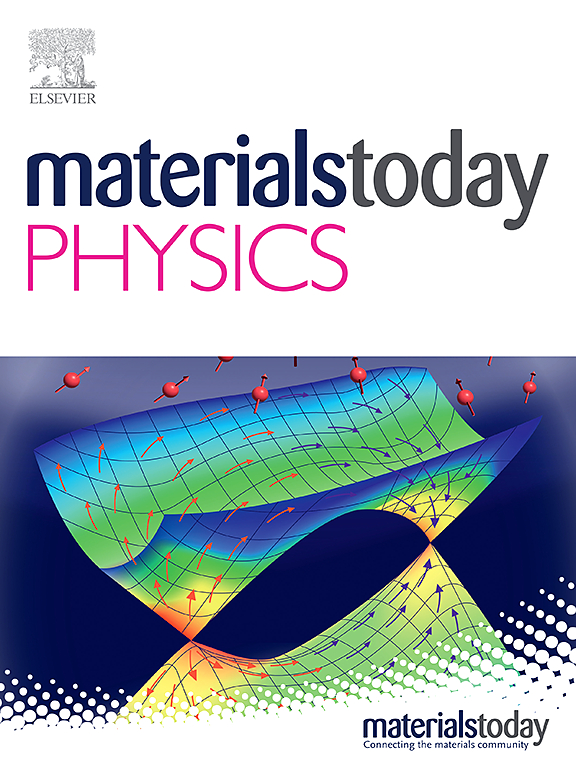Enhancing energy storage performance of antiferroelectric NaNbO3-Bi1/3SbO3 ceramics guided by first-principles calculations
IF 10
2区 材料科学
Q1 MATERIALS SCIENCE, MULTIDISCIPLINARY
引用次数: 0
Abstract
The application of Sodium niobate (NaNbO3, NN) ceramics with antiferroelectric (AFE) crystal phase faces the severe limitations in low energy density and efficiency due to the instability of the antiferroelectric phase and relatively low breakdown strength. The traditional methods still rely on a large amount of experimental verification. However, the internal mechanism remains unclear. To address this challenge, in the present study, the results of A-site defect engineering from density function theory (DFT) guides to design the modified ingredient of (1-x)NaNbO3-xBi1/3SbO3 ceramics with more stable AFE P phase. The theoretical results indicate that the BiSbO3 (BS) doping helps to induce a crystal phase transition from the stable ferroelectric (FE) to the more stable AFE state, with an energy difference of 9.762 meV. The main reason is that doping with BS suppresses the distortion index D of BO6 from 4.39 to 2.86 and increases the θc averaged tilting angle from 25.5 to 26.4, thereby significantly stabilizing the AFE P phase. However, this also generates Na vacancies, necessitating the formation of oxygen vacancies to maintain defect balance, which adversely affects the structural stability and breakdown strength of NN. First-principles calculations indicate that inhibiting oxygen vacancy formation raises the bandgap from 1.41 to 2.45 eV, thereby enhancing structural stability and breakdown strength. Guided by these theoretical insights, doped NN ceramics were heat-treated in oxygen atmosphere, and their insulation performance was evaluated. The results confirm the effectiveness of the oxygen vacancy suppression strategy. Ultimately, the experimental findings support our theoretical predictions, providing a strong theoretical and experimental foundation for improving the energy storage performance of NN-based AFE ceramics.
基于第一性原理计算增强反铁电NaNbO3-Bi1/3SbO3陶瓷储能性能
由于反铁电相的不稳定性和相对较低的击穿强度,铌酸钠(NaNbO3, NN)反铁电相陶瓷的应用面临着能量密度和效率低的严重限制。传统的方法仍然依赖于大量的实验验证。然而,其内部机制尚不清楚。为了解决这一挑战,在本研究中,密度泛函理论(DFT)的a位缺陷工程结果指导设计具有更稳定AFE P相的(1-x)NaNbO3-xBi1/3SbO3陶瓷的改性成分。理论结果表明,掺杂BiSbO3 (BS)有助于诱导晶体从稳定的铁电态(FE)向更稳定的AFE态转变,其能量差为9.762 meV。主要原因是BS的掺入抑制了BO6的畸变指数D从4.39增加到2.86,θc平均倾斜角从25.5增加到26.4,从而显著稳定了AFE P相。然而,这也会产生Na空位,需要形成氧空位来维持缺陷平衡,这对NN的结构稳定性和击穿强度产生不利影响。第一性原理计算表明,抑制氧空位形成使带隙从1.41 eV提高到2.45 eV,从而提高了结构稳定性和击穿强度。在这些理论见解的指导下,在氧气气氛中对掺杂神经网络陶瓷进行了热处理,并评估了其绝缘性能。结果证实了氧空位抑制策略的有效性。最终,实验结果支持了我们的理论预测,为提高nn基AFE陶瓷的储能性能提供了强有力的理论和实验基础。
本文章由计算机程序翻译,如有差异,请以英文原文为准。
求助全文
约1分钟内获得全文
求助全文
来源期刊

Materials Today Physics
Materials Science-General Materials Science
CiteScore
14.00
自引率
7.80%
发文量
284
审稿时长
15 days
期刊介绍:
Materials Today Physics is a multi-disciplinary journal focused on the physics of materials, encompassing both the physical properties and materials synthesis. Operating at the interface of physics and materials science, this journal covers one of the largest and most dynamic fields within physical science. The forefront research in materials physics is driving advancements in new materials, uncovering new physics, and fostering novel applications at an unprecedented pace.
 求助内容:
求助内容: 应助结果提醒方式:
应助结果提醒方式:


